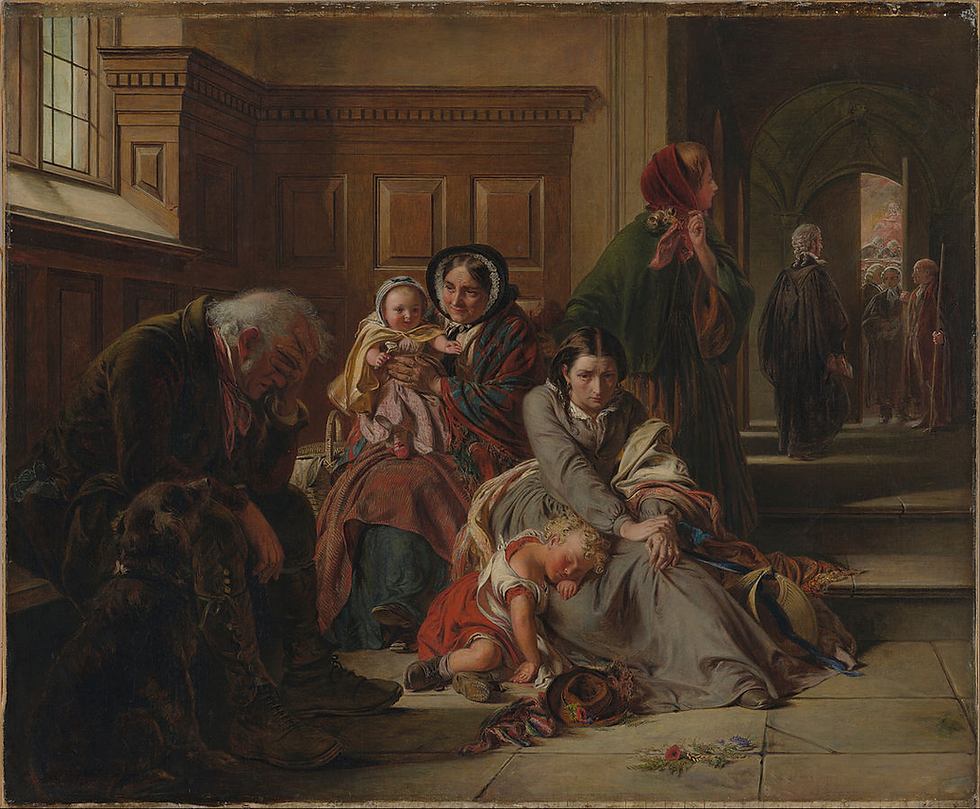Personality Series: Emotional Stability
- David Saeteros

- Jul 24, 2022
- 7 min read
Updated: Sep 14, 2024
Foreword
Human personality is a well-known concept in both academic and non-academic circles. This concept has raised the most diverse conclusions in both circles: from well-established factorial solutions to classifications of people based on what the Sorting Hat from Hogwarts would estimate. For a long time now, research in psychology has gained plenty of knowledge about human personality and its implications in everyday life, but this knowledge is either unknown or misunderstood by the general population. This situation calls for efforts to close this gap between what is known based on science and what is assumed to be true based on our random and subjective experience. The following series explores the most consensual contemporary conceptualization of personality, the creative steps scientists took to arrive at this conceptualization using the lexical hypothesis, the specificities of this contemporary conceptualization by looking at each one of the Big Five traits, and the implications of each trait for individuals and societies.
The Personality Series is divided into 5 chapters:
Personality Series: Emotional Stability
One of the personality traits that have the worse reputation in popular psychology is neuroticism, known positively as emotional stability. The name in itself, neuroticism, has not been very well regarded in psychology history. For many years, since William Cullen in 1769, the neurotic person was the person with general affection for the nervous system (Knoff, 1970). Later, in 1952, in the extant edition of the Diagnostic and Statistical Manual of Mental Disorders, one can find a whole section called the “psychoneurotic disorders” meaning disorders characterized by “anxiety which may be directly felt and expressed or which may be unconsciously and automatically controlled by the utilization of various psychological defense mechanisms” (American Psychiatric Association, 1952). Although there are still some traces that these conceptualizations share with the current conceptualization of neuroticism as a personality trait, important distinctions need to be considered. In this article, the main features of neuroticism and its influence on life outcomes are going to be presented.

It is very common to deal with neurotic people every day. Either at work or home, there is bound to be a slightly more neurotic person than ourselves. What a neurotic person looks like can be found in very famous TV shows, like Piglet in Winnie The Pooh, or Angela in The Office. More technically, neuroticism is a fundamental trait found in different personality taxonomies which refers to the tendency to experience negative emotional states (Widiger, 2009). And yes, Piglet is always nervous and afraid of many innocuous stimuli in their environment and Angela cannot seem to find much joy in her everyday activities. Including party planning (The Office, 2005).
This definition might be a bit misleading, though. All people have experienced negative emotional states and, at first sight, this does not make it evident why so much attention has been given to neuroticism. The important part is the “tendency” part. All personality traits show some kind of default form of operation. That is precisely what personality is: stable dispositions to think, feel, and react (Funder, 2012). Thus, a person would not fall in the category of “high in neuroticism” unless they would present this disposition and behave accordingly.

Precisely speaking, these negative emotions include anxiety, anger, guilt, and depression. Whereas a rejection at the bar from a woman would be taken almost “matter-of-factly” by a less neurotic person, individuals high in neuroticism are more likely to interpret this situation as threatening. They also experience more self-consciousness, and shyness, and are less able to control their impulses when feeling upset. Other common emotional states are fear, sadness, embarrassment, disgust, and vulnerability (Widiger, 2009).
Some authors have summarized neuroticism in two terms: volatility and withdrawal (DeYoung et al., 2007). The first means having low stability in emotions and their regulation, with people getting upset easily, being unable to keep emotions under control, changing moods a lot in short periods, or getting easily agitated. The second means regularly feeling blue, threatened, easily discouraged, afraid, and overwhelmed (Widiger, 2009). In summary, neuroticism could be explained by not being emotionally stable —in fact, the HEXACO taxonomy of personality traits drops the term neuroticism and changes it to emotional stability (Ashton & Lee, 2007)—, and by not being able to cope with negative life experiences resorting to negative emotions to buffer their impact.
It is not difficult to imagine how a person with this tendency would react in their daily life. From the TV shows mentioned above, one can easily picture how the life of a neurotic person would be. This pattern of behaviors would lead to what psychologists have defined as another essential aspect of neurotic individuals: dependency. To react constantly as if every situation in life is negative, leads eventually to submissive and clinging behavior, with some fear of separation from a significant one or from a group that provided some stability that cannot be found elsewhere (Widiger, 2009).
Interestingly, despite having all these perks, neuroticism makes a lot of sense from an evolutionary perspective (Price, 2003). Anxiety, at normal levels, helps individuals to be more attentive in threatening situations, and, not so many thousands of years ago, that meant higher chances of survival. If there ever was an individual with no anxiety, their chances of survival would have been meager, such an approach is not an adaptive strategy in the world. On the other hand, vulnerability is linked with social support: the moment someone shows signs of vulnerability to their peers and social circles, if they have been adequately chosen, they will probably step up to support the affected person. Getting this kind of support from a social circle is an evolutionary advantage (Widiger, 2009).

However, virtue stands in the middle, as it is said. Neuroticism has been linked with various psychopathologies and physical illnesses like hypertension, cardiovascular diseases, and diabetes. It has also been linked with existential concerns, weaker identity integration, dissatisfaction, conflict with relationships, and financial insecurity (Ozer & Benet-Martínez, 2006). Neuroticism is indeed one of the strongest predictors of negative life outcomes.
Emotional stability is the other side of the coin, characterized by the evenness of moods. Its markers are also optimism, cheerfulness, composure, feelings of being healthy, and freedom from guilt, worry, or loneliness (Thorndike et al., 1991). The core of emotional stability is a sense of ownness of emotions and having a positive outlook on life and existence. Bad situations are evaluated evenly and from a strong ego, not taking things personally when they are not (Chaturvedi & Chander, 2010).
As a final point, it has been proposed that reacting in a bad way in front of negative events may perpetuate the circle of negative events, this is known as the evocative person-environment transaction (Smith, 2009). The basic functioning principle is: whatever you put out there, you get. If someone reacts negatively to negative events, others may be annoyed by this reaction and consequently try to avoid the person in question. This will only lead to less supportive environments and more negative emotions. A negative outlook in life has been linked to many different negative outcomes: fewer friends, fewer good opportunities, a mediocre job, a failed marriage, etc. (Ozer & Benet-Martínez, 2006).

Not everything is bad, though. Personality psychologists must stress the importance of finding the right environment. This is one of the jobs of vocational psychology: an extraverted person will be the right fit for a sales department, not so much an intraverted person. A person high in neuroticism will be great in environments where their ability to detect threats can be used to their advantage. Such a person would have a good performance as a teacher, a caretaker, a doctor, or a nuclear plant manager. Furthermore, it has been shown that women tend to score higher in neuroticism than men (Weisberg et al., 2011), giving them an evolutionary advantage in offspring care. The fit between person and environment is a challenge every human has to go through. Even the most unfortunate of traits will be appreciated in the right environment.
Bibliographical resources
American Psychiatric Association. (1952). Diagnostic and Statistical Manual Mental Disorders. http://archive.org/details/dsm-1
Ashton, M. C., & Lee, K. (2007). Empirical, Theoretical, and Practical Advantages of the HEXACO Model of Personality Structure. Personality and Social Psychology Review, 11(2), 150–166. https://doi.org/10.1177/1088868306294907
Chaturvedi, M., & Chander, R. (2010). Development of emotional stability scale. Industrial Psychiatry Journal, 19(1), 37–40. https://doi.org/10.4103/0972-6748.77634
DeYoung, C. G., Quilty, L. C., & Peterson, J. B. (2007). Between facets and domains: 10 aspects of the Big Five. Journal of Personality and Social Psychology, 93(5), 880–896. https://doi.org/10.1037/0022-3514.93.5.880
Funder, D. C. (2012). The Personality Puzzle (pp. xxvii, 466). WW Norton & Co.
Knoff, W. F. (1970). A history of the concept of neurosis, with a memoir of William Cullen. The American Journal of Psychiatry, 127(1), 80–84. https://doi.org/10.1176/ajp.127.1.80
Ozer, D. J., & Benet-Martínez, V. (2006). Personality and the Prediction of Consequential Outcomes. Annual Review of Psychology, 57(1), 401–421. https://doi.org/10.1146/annurev.psych.57.102904.190127
Price, J. S. (2003). Evolutionary aspects of anxiety disorders. Dialogues in Clinical Neuroscience, 5(3), 223–236.
Smith, G. T. (2009). Why do Different Individuals Progress Along Different Life Trajectories? Perspectives on Psychological Science : A Journal of the Association for Psychological Science, 4(4), 415–421. https://doi.org/10.1111/j.1745-6924.2009.01148.x
The Office. (2005, March 24). Reveille Productions, NBC Universal Television, 3 Arts Entertainment.
Thorndike, R. M., Cunningham, G. K., Thorndike, R. L., & Hagen, E. P. (1991). Measurement and evaluation in psychology and education, 5th ed (pp. xvi, 544). Macmillan Publishing Co, Inc.
Weisberg, Y. J., DeYoung, C. G., & Hirsh, J. B. (2011). Gender Differences in Personality across the Ten Aspects of the Big Five. Frontiers in Psychology, 2, 178. https://doi.org/10.3389/fpsyg.2011.00178
Widiger, T. A. (2009). Neuroticism. In Handbook of individual differences in social behavior (pp. 129–146). The Guilford Press.
Visual sources
Figure 1: Solomon, A. (1859). Waiting for the Verdict [Oil on canvas]. Getty Center. https://commons.wikimedia.org/wiki/File:Abraham_Solomon_(British_-_Waiting_for_the_Verdict_-_Google_Art_Project.jpg
Figure 2: Mednyánszky, L. (1878). Kneeling Convict [Oil on canvas]. Slovak National Gallery. https://commons.wikimedia.org/wiki/File:Ladislav_Medny%C3%A1nszky_-_Kneeling_Convict_-_O_4930_-_Slovak_National_Gallery.jpg
Figure 3: Delacroix, E. (1841). Christ sur la mer de Galilée [Oil on canvas]. The Nelson-Atkins Museum of Art. https://commons.wikimedia.org/wiki/File:Eug%C3%A8ne_Delacroix_-_Christ_on_the_Sea_of_Galilee_-_Google_Art_Project.jpg
Figure 4: Rubens, W. of P. P. (1617). The Judgement of Solomon [Oil on canvas]. Statens Museum for Kunst. https://commons.wikimedia.org/wiki/File:Workshop_of_Peter_Paul_Rubens_-The_Judgement_of_Solomon.jpg







Fans of parkour and high-speed action will love cluster rush. The goal is to jump from moving truck to truck through mind-bending levels. With increasing difficulty and wild momentum, it never gets boring. It’s a perfect blend of chaos and strategy.
I am also a new user and have geometry dash meltdown posted abfi on this forum.
A well-structured article, with clear examples, creating a discourse that does not estrange a non-specialist public, but entice it to delve deeper into the topic.
I loved how you explained such a theoretical concept with modern-day examples. It allows keeping the attention of the audience without losing the deep of the topic. The article is very well structured with a clear development while the conclusion highlights the importance of surroundings by leaving the door open about how the right environment can affect the traits.